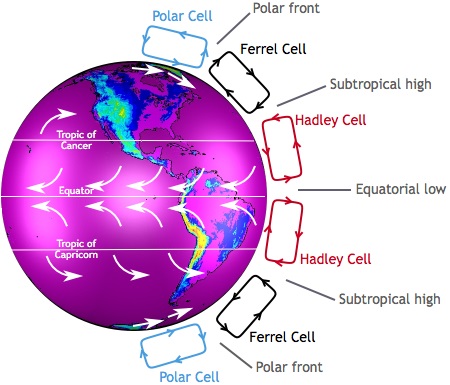Differential heating of the Earth’s surface results in equatorial regions receiving more heat than the poles. As air is warmed at the equator it becomes less dense and rises, while at the poles the cold air is denser and sinks. If the Earth was non-rotating, the warm air rising at the equator would reach the upper atmosphere and begin moving horizontally towards the poles. As the air reached the poles it would cool and sink, and would move over the surface of Earth back towards the equator. This would result in one large atmospheric convection cell in each hemisphere with air rising at the equator and sinking at the poles, and the movement of air over the Earth’s surface creating the winds. On this non-rotating Earth, the prevailing winds would thus blow from the poles towards the equator in both hemispheres.In reality the Earth’s rotation makes this atmospheric circulation a bit more complex. The paths of the winds on a rotating Earth are deflected by the Coriolis Effect.
In the Northern Hemisphere, the apparent Coriolis deflection will always be to the right. In the Southern Hemisphere the situation is reversed. Objects moving towards the equator from the south pole are moving from low speed to high speed, so are left behind and their path is deflected to the left. Movement from the equator towards the south pole also leads to deflection to the left. In the Southern Hemisphere, the Coriolis deflection is always to the left from the point of origin. Because of the rotation of the Earth and the Coriolis Effect, rather than a single atmospheric convection cell in each hemisphere, there are three major cells per hemisphere. In between these wind bands lie regions of high and low pressure. High pressure zones occur where air is descending, while low pressure zones indicate rising air. In addition to their role in creating the surface winds, these high and low pressure systems also influence other climatic phenomena.
Reflexive Analysis
This article informs how and why air moves in the patterns it does in our atmosphere. By explaining how air moves in these convection cells of rising and falling actions, we see this same repeating shape of the convection cell. It also gives insight into how nature changes air pressure which birds manipulate to generate/maintain lift and mitigate drag. These convection cells influence not only the mechanics of flight, but also when flight is even possible due to its influence on weather. These sorts of changes in atmosphere affect migration patterns and who can manage to fly where. This article also once again ties back to the ocean and the similarities between the movements of air and water as fluids. I find it interesting how the shapes of these movements repeat at different scales and in different contexts in my research thus far of flight.
Sources
Libretexts. (2022, January 7). 8.3: Atmospheric and ocean circulation. Biology LibreTexts. https://bio.libretexts.org/Courses/University_of_Pittsburgh/Environmental_Science_(Whittinghill)/08%3A_Atmosphere_and_Air_Pollution/8.03%3A_Atmospheric_and_Ocean_Circulation




